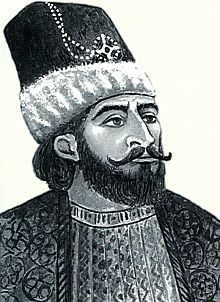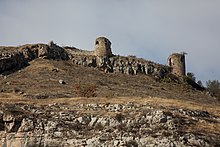Shusha fortress
Şuşa Fortress ( Azerbaijani Şuşa qalası ) is a building erected in the 18th century in the Nagorno-Karabakh region of Azerbaijan .
Backstory
With the collapse of the Afsharid dynasty in Iran , various feudal states , called khanates , arose in the area of today's Azerbaijan from the middle of the 18th century . Each of these formations had their own domains and was independent in terms of domestic and foreign policy. The Karabakh Khanate , which was one of the most powerful and influential states at the time, achieved this extensive independence under Panah Ali Khan in 1747 after the death of Nader Shah , the Shah of Persia. He came from the Cavanşir clan (Dschawanschir), who in turn belonged to the Afshars , an important Oghuz tribe of Turkish origin. Similar to the other feudal rulers of his time, Panah Ali Khan needed strong fortifications to defend himself against external enemies and to assert the sovereignty of his state. He therefore decided to have his fortress built in a strategic location that would have enabled him to control large territories from the Aras River to Lake Göyçə (now Lake Sevan in Armenia ) as well as the provinces of Sissian , Meghri and Sangesur in the south.
Construction and architectural features

The foundation stone of the bulwark built on the top of a high hill and consisting of three main gates ( Gəncə , İrəvan or Yerevan and Aghaoglan) was laid in 1751. The construction work was under the direct supervision of Molla Pənah Vaqif , the famous Azerbaijani poet and vizier of the Karabakh Khanate, and was completed that same year. Panah Ali Khan had a residential castle built within the fortress wall. The area on which the building is located is a mountain plateau with great views, which rises in the shape of an amphitheater and has numerous hills. The highest point of the plateau is 1,600 meters above sea level. The military-strategic advantages of the defensive system, which are considered unacceptable, were emphasized by the British traveler G. Keppel or the Russian politician Platon Alexandrovich Subow . According to the Russian historian Vassili Potto, the topographical features played a key role in the failure of the Persian military campaign to Karabakh, when the troops of the Crown Prince and Abbas Mirza were unable to take the fortress for 48 days.
The erection of the fortress is considered to be the actual hour of birth of the city of Şuşa , which was then called Panachabad. The name Şuşa only prevailed in the 19th century and was probably derived from the name Şuşakənd (Schuschakend), a nearby place. A rapid development experienced the fortified city in the 19th and 20th century, when there are many Madrasa s, mosques (such as the adjustable upper and lower Gowhar-Agha mosques), caravanserai (z. B. caravanserai Agha Qahraman Mirsiyab) s, museums ( Historical Museum of Şuşa), palaces and memorial houses for the prominent sons and daughters of the city (Ibrahim Chalil Khan, Xurşidbanu Natəvan , Üzeyir Hacıbəyov , Molla Pənah Vagif, Bülbül etc.) were built. Şuşa is considered to be the cradle of Azerbaijani music and culture. In 1977 the leadership of the Communist Party of Azerbaijan proclaimed the historical core of the city to be the country’s historical-architectural reserve.
present
Şuşa was occupied by Armenian troops on May 9, 1992 in the course of the Nagorno-Karabakh War. Most of the architectural monuments within the fortress such as the mosques Mamayi, Mardinli, Təzə Məhəllə, the memorial houses of Natəvan, Üzeyir Hacıbəyov and Mir Mövsun Nəvvab (Mir Mohsun Nawwab), the mausoleum of Vagif etc. were looted and burned down. The other monuments such as the Upper and Lower Gowhar Agha Mosques and the fortress itself remained in a deserted state for a long time. In the last few years extensive restoration work has been carried out by the " Nagorno-Karabakh Republic ", which is not recognized internationally . In this context, for example, the Upper Gowhar Agha Mosque was repaired at the end of 2019 and presented to the public as a Persian mosque. In Azerbaijan, the Armenian side was accused of either removing the cultural and religious heritage of the Azerbaijanis from the cityscape, or of deliberately "persisting" it under the pretext of restoration.
Literature and individual references
- ^ Richard Tapper: Frontier Nomads of Iran: A Political and Social History of the Shahsevan . Cambridge University Press, 1997, ISBN 0-521-47340-3 , pp. 114-115 .
- ↑ Абдуллаев Гаси: Азербайджан в XVIII веке и взаимоотношения его с Россией (Azerbaijan in the 18th century and its relations with Russia) . Изд-во Акад. наук АзССР (Academy of Sciences of the Azerbaijani SSR), Баку 1965, p. 14 .
- ↑ Авалов, Эльтуран: Архитектура города Шуши и проблемы сохранения его исторического облика . Издательство «Элм», Баку 1977, p. 17 .
- ↑ Василий Потто: Защита Шуши (Персидская война 1826-1828 гг.). "Кавказская война в отдельных очерках, эпизодах, легендах и биографиях" . tape 3 . Тип. Е. Евдокимова, Санкт Петербург 1886, p. 93 .
- ↑ Ахмед бек Джеваншир: О политическом существовании Карабахского ханства с 1747 по 1805 г. (On the Political Affairs of the Karabakh khanate in 1747–1805) . типо-лит. А. М. Мугдусиакопова, Шуша 1901, p. 15 .
- ↑ Томас де Ваал: Глава 12. Шуша. Последняя цитадель. Главы из русского издания книги "Черный сад". In: BBC Russia. July 12, 2005, Retrieved July 4, 2020 (Russian).
- ↑ Susha historical and architectural reserve. In: Unesco.org. October 24, 2001, accessed July 4, 2020 .
- ↑ Azerbaijan. Seven Years of Conflict in Nagorno-Karabakh. In: Human Rights Watch / Helsinki. December 1994, accessed July 5, 2020 .
- ^ Council of Europe: Parliamentary Assembly (ed.): Documents: Working papers, 2004 ordinary session (second part) . Strasbourg 2004, ISBN 92-871-5576-3 , p. 361 .
- ^ Marja van Heese: The war over Nagorno-Karabakh and its Lasting Effects on Cultural Heritage . In: Jeroen Rodenberg / Pieter Wagenaar (eds.): Cultural Contestation: Heritage, Identity and the Role of Government . Palgrave Macmillan, London 2018, ISBN 978-3-319-91913-3 , pp. 177-197 .
- ↑ Solemn event dedicated to the completion of Gohar Agha Upper Mosque's restoration took place in Shushi. October 14, 2019, accessed on July 5, 2020 .
- ↑ Azerbaijani official: Mosque damaged by Armenia under pretext of repair testifies again to its aggressive policy. In: The State Committee on Religious Associations of the Republic of Azerbaijan. October 7, 2019, accessed on July 5, 2020 .


